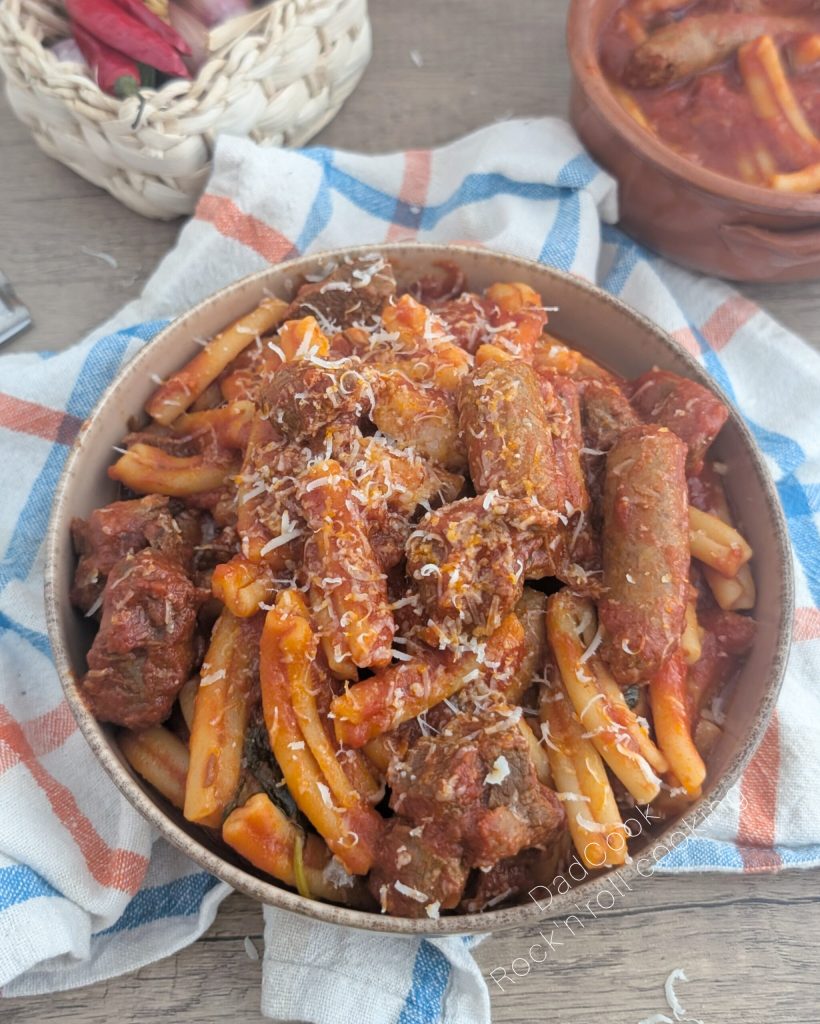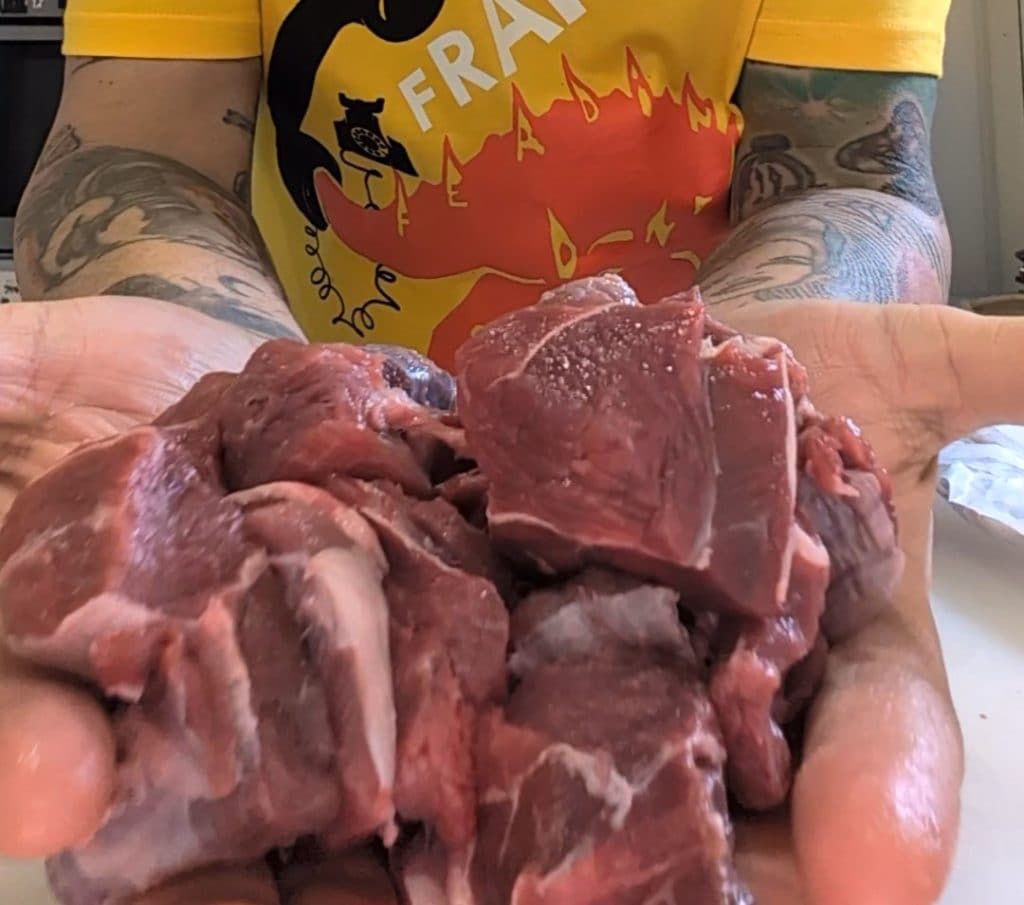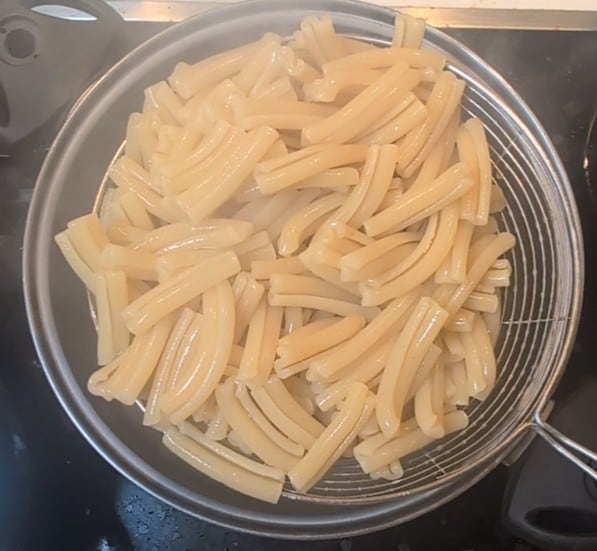Every time the train approaches my homeland, my heart starts to beat faster. The hills turn green, and the scent of the sea mixes with that of the land.
And then, finally, I cross the threshold of home, where I’m always greeted by the same unmistakable smell: that of ragù simmering slowly, enveloping every corner of the kitchen in a warm and welcoming embrace.
Calabrian ragù is the flavor of my childhood, of Sundays spent around the table with family, of festivals where my grandmother, with her expert hands, prepared this dish that is a true symbol of our tradition.
I remember the intense aroma of the meat slowly melting into the sauce, the spiciness of the sausage tickling the tongue, the crust of bread dipped into the thick and flavorful sauce.
Each spoonful is a journey through time, a return to the roots, a way to rediscover that sense of belonging that only homemade cooking can give.
This ragù is the story of my family, passed down from generation to generation, a precious treasure I keep in my heart and want to share with you.
Today, I will reveal to you the secrets of the original recipe, the one my grandmother taught me, hoping you can savor a bit of my Calabria and relive the emotions this dish evokes in me.

- Difficulty: Very Easy
- Cost: Economical
- Rest time: 30 Minutes
- Preparation time: 15 Minutes
- Portions: 8
- Cooking methods: Slow Cooking, Stovetop
- Cuisine: Italian
- Seasonality: Autumn, Winter, All Seasons
- Energy 374.97 (Kcal)
- Carbohydrates 10.89 (g) of which sugars 0.98 (g)
- Proteins 33.88 (g)
- Fat 22.25 (g) of which saturated 4.00 (g)of which unsaturated 5.91 (g)
- Fibers 1.70 (g)
- Sodium 947.12 (mg)
Indicative values for a portion of 280 g processed in an automated way starting from the nutritional information available on the CREA* and FoodData Central** databases. It is not food and / or nutritional advice.
* CREATES Food and Nutrition Research Center: https://www.crea.gov.it/alimenti-e-nutrizione https://www.alimentinutrizione.it ** U.S. Department of Agriculture, Agricultural Research Service. FoodData Central, 2019. https://fdc.nal.usda.gov
Ingredients
To create an authentic Calabrian ragù, it is essential to carefully select each ingredient.
The combination of meats, fresh vegetables, and intense aromas is what gives this dish its unique and enveloping flavor.
Here are the essential elements that will accompany us on this culinary journey:
- 14 oz beef (Beef shank)
- 7 oz pork (Lean pork pulp)
- 4 Calabrian sausages (With fennel)
- 5 oz fresh pancetta
- 6 cups tomato puree
- 2 onions
- 0.4 cups white wine
- 3 leaves bay leaf
- 1 bunch basil
- 1 pinch nutmeg
- 4 tablespoons extra virgin olive oil
- 1 tablespoon coarse salt
- 1 pinch black pepper
Calabrian ragù is a rich and substantial dish that provides a good amount of proteins, carbohydrates, and fats.
The presence of different meats, such as beef shank, pork pulp, and sausage, makes it an important source of animal proteins.
Tomato sauce, rich in lycopene, a natural antioxidant, contributes to the intake of vitamins and minerals.
However, it is important to consider that ragù is also a caloric dish, so it is advisable to consume it in moderation as part of a balanced diet.”
The detailed nutritional information may vary based on the specific quantities of ingredients used and the preparation methods.
Tools
To prepare a rich and flavorful Calabrian ragù, you will need some essential tools.
A large terracotta or cast iron pot is ideal for the long slow cooking, which allows the flavors to blend perfectly and distributes heat evenly. Alternatively, you can also use a stainless steel pot.
A sturdy cutting board and a sharp knife will help you prepare the meats and vegetables.
Don’t forget a wooden spoon to gently stir the ragù during cooking, and kitchen tongs to handle the meats safely.
With these tools, you will be ready to create a Calabrian ragù that will delight your guests and bring you back to the authentic flavors of tradition.
- 1 Terracotta Pot Coli maioliche
- 1 Cutting Board Lacers
- 1 Wooden Spoon Bivofu
- 1 Knife Cutluxe
Steps
Follow these steps carefully to prepare an authentic Calabrian ragù, rich in the flavors and aromas of tradition.
The long slow cooking is the secret to obtaining a thick and full-bodied sauce, where the meat melts in the mouth and the flavors blend harmoniously.
Get ready for a culinary journey that will bring you back to the genuine flavors of Calabria.
Cut the meat:
Start by preparing the meats for the ragù. Take the beef shank, a flavorful and slightly marbled cut, the pork pulp, leaner and tender, the Calabrian sausage, which will give a spicy and aromatic touch, and the pancetta, to add a note of smoky flavor.Cut everything into pieces of 1 to 1.5 inches. This helps the meat cook evenly and absorb the sauce’s flavor during the long cooking.

Prepare the soffritto
Pour a generous drizzle of extra virgin olive oil into the pot, preferably terracotta for more even cooking. Sauté the finely chopped onion until golden and translucent.
Add the bay leaves broken in half, which will release an intense aroma. When the onion is ready, place the meat in the pot and brown it well on all sides to seal in the juices.
Then pour about a glass of white wine and wait for the alcohol to evaporate, leaving only the aroma.

Prepare the tomato sauce
When the wine has evaporated, remove the meat from the pot and set it aside, covered to keep it warm.In the pot, pour two bottles of tomato puree for a rich and full-bodied sauce, and a tablespoon of concentrate to intensify the flavor.
Mix well and cook for 15 minutes to slightly thicken the sauce.

Cook the ragù:
Put the meat back into the sauce, adding the bay leaves used earlier. Lower the heat to the minimum, cover the pot, and cook the ragù for 4 and a half hours, stirring occasionally to avoid sticking.
Finally, adjust the salt if necessary and add fresh basil.
If you don’t want to serve cooked basil leaves, use whole sprigs so you can easily remove them before serving.

Let the ragù rest:
The ragù is ready, but to make it even more flavorful, let it rest for 30 minutes with the heat off, the lid slightly ajar.
In the meantime, cook the pasta in plenty of salted water, choosing a shape that pairs well with the ragù, like ziti or rigatoni.
Drain it al dente and put it in the pot with the ragù, stirring to coat it well.

Serve:
Put the pasta on plates, add more ragù if necessary, and a generous sprinkle of grated cheese, such as pecorino or parmesan.A drizzle of raw extra virgin olive oil will add an extra touch of flavor.
The Calabrian ragù is ready to be enjoyed, a rich and comforting dish, perfect for a family lunch.

Calabrian ragù is a rich and versatile dish that lends itself to various interpretations and is easily preserved.
Here are some tips, variations, and suggestions for best preserving your ragù.
Tips;
Meat: For a more flavorful ragù, use a mix of meats, like beef, pork, and sausage.
Cooking: Slow cooking is essential for a tender and flavorful ragù. Don’t rush!
Flavor: For an extra touch, add a pinch of Calabrian chili pepper during cooking.
Pasta: Dress the ragù with fresh or dry pasta, choosing shapes like ziti, rigatoni, or macaroni.
Cheese: Complete the dish with a generous sprinkle of grated cheese, like pecorino or parmesan.
Wine: If desired, you can add half a glass of red wine during cooking, as a replacement or in addition to the white wine.
Variations
White Ragù: Prepare a version without tomato, using only meat, vegetables, and white wine.
Wild Boar Ragù: Replace traditional meats with wild boar for a wilder flavor.
Vegetarian Ragù: Use mushrooms, vegetables, and legumes for a vegetarian version of the ragù.
Meatballs: Add pre-fried meatballs to the ragù to further enrich the dish.
Preservation:
Calabrian ragù keeps in the refrigerator for 3-4 days in an airtight container.
You can also freeze it in single portions to have it always available.
When freezing, it is advisable to use glass containers.
When using, thaw it slowly in the refrigerator or at room temperature.
Reheat it slowly, adding a little water or broth if necessary.

FAQ (Frequently Asked Questions)
Here are some of the most frequently asked questions about Calabrian ragù. If you have other curiosities, feel free to ask in the comments!
Can I use other types of meat?
Yes, you can vary the meats according to your taste. Some even use wild boar or lamb. The important thing is to choose cuts suitable for long cooking.

Can I prepare the ragù in advance?
Certainly! Calabrian ragù is even better the next day. Prepare it in advance and store it in the refrigerator or freeze it in portions.
What type of pasta do you recommend?
Tradition calls for ziti, rigatoni, or caserecce, but fresh pasta also pairs well. Choose a shape that holds the sauce well.
Can I use fresh tomatoes instead of the puree?
Yes, you can use about 3.3 lbs of ripe fresh tomatoes. Blanch them, peel them, remove the seeds, and chop them. You’ll get a ragù with a more intense flavor.
How can I make the ragù spicier?
Add a pinch of Calabrian chili powder or some pieces of fresh chili during cooking. Adjust the amount to your taste.

